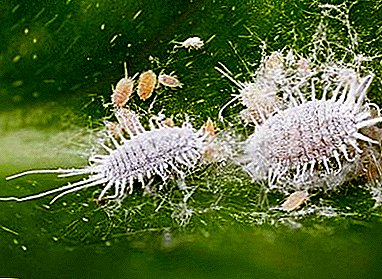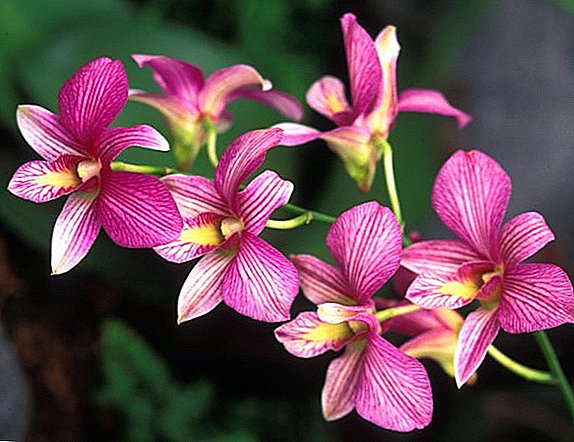 Dendrobium orchid is a perennial belonging to the Orchid family and numbering more than a thousand species. "Living on a tree" - this is how the name translates from Greek. The dendrobium in its natural environment grows like an air orchid, an epiphyte, and there are less common lithophytes, that is, growing on stones. Homeland dendrobium are tropical forests of New Guinea, Australia, China, Japan. Since this is a tropical plant, it is necessary to take care of the dendrobium accordingly: to provide it with the necessary temperature and humidity, the level of illumination, suitable soil, food, change of periods of flowering and dormancy.
Dendrobium orchid is a perennial belonging to the Orchid family and numbering more than a thousand species. "Living on a tree" - this is how the name translates from Greek. The dendrobium in its natural environment grows like an air orchid, an epiphyte, and there are less common lithophytes, that is, growing on stones. Homeland dendrobium are tropical forests of New Guinea, Australia, China, Japan. Since this is a tropical plant, it is necessary to take care of the dendrobium accordingly: to provide it with the necessary temperature and humidity, the level of illumination, suitable soil, food, change of periods of flowering and dormancy.
Dendrobium orchid: flower description
The plant most often has a height of about half a meter, individual instances can grow up to a meter. The stem of the dendrobium is made up of cylindrical pseudobulbs, the leaves on it are arranged alternately, and peduncles containing from one to four flowers grow from the sinuses. Dendrobium flowers are one-color, two-color, and even tricolor; the most diverse colors: pink, yellow, orange, white, lilac. 
The best conditions for growing dendrobium
If you were given a dendrobium orchid, and you do not know how home care is carried out, do not worry: the care is not too troublesome, but the result will always please you.
How much light is needed to grow dendrobium
Like all tropical plants, the dendrobium loves a lot of light, therefore it is better to place it on the southwestern or southeastern windowsill. Having placed a flower on the south window, in summertime you should shade it, on the north - in the winter to illuminate it.
Dendrobium signals the quality of illumination by leaf color:
- about the lack of light - dark green;
- acute shortage - yellow;
- about surplus - salad;
- about sufficient lighting - green.
Important! From direct sunlight, the dendrobium can suffer and even get burned; it prefers diffused light.
Temperature and humidity for successful growth
Dendrobium bush orchid does not tolerate extreme heat, besides it must be provided with a natural difference of night and day temperatures.
 The optimum air temperature for this flower at night is 18 ° С, in the daytime 25 ° С, in autumn and winter it should be lowered to 12-18 ° С, respectively. Lowering the temperature of the content, reducing watering and intensive replenishment of the dendrobium in the fall and winter will ensure flowering.
The optimum air temperature for this flower at night is 18 ° С, in the daytime 25 ° С, in autumn and winter it should be lowered to 12-18 ° С, respectively. Lowering the temperature of the content, reducing watering and intensive replenishment of the dendrobium in the fall and winter will ensure flowering.
Under conditions of high temperature, the plant produces curves and shriveled young leaves, when it is too high — above 33 ° C — the roots stop absorbing water, and the leaves actively evaporate it, which leads to drying.
Humidity should reach 50-60%. To ensure the desired level, you should spray the dendrobium daily or every other day, you can add sphagnum moss to the pots or pour the clay into the pan and moisten it periodically.
Soil requirements
As soil for dendrobium is used epiphyte substratewhich is sold in specialty stores. You can make it yourself. Dendrobium should be watered in the spring and summer twice a week, in the fall - once; In winter, the dendrobium is dormant, so watering is done once a month.
Dendrobium is watered when the roots and substrate are almost or completely dry.
Important! Watering, you need to protect young bulbs from water: it can lead them to rot.
 Watering is done in the following way: the pot with the plant is immersed in warm water, after 10-15 minutes it is allowed to drain and the flower is sent into place.
Watering is done in the following way: the pot with the plant is immersed in warm water, after 10-15 minutes it is allowed to drain and the flower is sent into place.During the period April-September, during growth, the dendrobium is fed a week later or every week, adding fertilizer to the water for irrigation. To do this, use a special fertilizer for orchids or mineral complex fertilizer, which is diluted 2 to 3 times more than indicated in the instructions.
General rules for dendrobium orchid care
In its natural habitat, the dendrobium does not have a state of rest, its life cycle is continuous. As for home hybrids, in conditions of an unnaturally short daylight they hibernate, preparing for a new bloom. If the plant is not allowed to rest, extending the artificially light day, then a pseudobulb instead of a flower will release young shoots.
Care during flowering
It is impossible to say exactly when the dendrobium blooms. In our latitudes, this usually occurs during the cold season. But it happens that the dendrobium does not bloom, despite the favorable conditions.
Did you know? If the dendrobium is "frightened" by limiting resources - cold, lack of food, etc., it is activated from stress and begins to bloom.
Some possible reasons why Dendrobium does not bloom:
- Violation of the rest period of the plant makes him produce flowers, not cakes (kids);
- Pests that are bred on a flower and prevent it from carrying out a pledged program;
- Location in a stuffy room when the amount of air produced by the plant is insufficient;
- Lack of light or excessively high temperature;
- Excessive watering after the appearance of buds plunges the plant into a second hibernation.

Important! It is necessary to create the necessary conditions for the dendrobium to observe the life cycle. If it is not provided with a period of rest, it will completely stop blooming and instead of flowering, without rebuilding, it will begin to "fatten", consuming too much nutrition.
There are ways to make a dendrobium blossom:
- Provide the plant with a bright place, low temperature (16-18 ° C) and no watering.
- If by the beginning of spring the dendrobium does not wake up and does not release buds, feed in the next 2-3 irrigations with phosphate fertilizer.
- If a new sprout appears, stop watering until it reaches 2-3 cm and does not let its roots, then resume watering and grow it to the size of an old bulb, provide 12 ° C and stop watering until the buds open.
How to care for a dendrobium in a dormant period
At the end of flowering and until the fall, the dendrobium actively grows greens and produces children. In the autumn, from about mid-October, watering is gradually reduced and completely stopped by November; the air temperature is reduced to 15–18 daytime and 8–12 night degrees, preparing the plant for a rest period. The next two or three months, the plant should not be disturbed, it has come to rest and prepare for flowering.
Dendrobium: flower transplant
Dendrobium transplantation takes place every two to three years, at the end of flowering. This usually happens in spring. Before you transplant dendrobium at home, you should make sure that this action is necessary.
 A plant needs to be transplanted, whose roots began to deteriorate and hurt or grew and do not fit in a pot.
A plant needs to be transplanted, whose roots began to deteriorate and hurt or grew and do not fit in a pot.
A transplant is needed if the substrate in which the dendrobium grows has oxidized and needs to be replaced.
Important! The roots of the dendrobium are very fragile, you need to be extremely careful when transplanting.
As with other orchids, a dendrobium pot is required small, because its roots prefer a close space. At the bottom of the pot put large pieces of bark for drainage, sphagnum moss for moisture retention is placed on top. Water the transplanted plant no sooner than a week or a half.
Reproduction of dendrobium
The reproduction of orchid dendrobium at home is carried out by vegetative means. There are three ways to do this:
- grafting;
- division;
- reproduction with cakes (kids).
Did you know? With proper reproduction and proper care, orchids grow quickly, increasing the volume of the roots.
How to cutting a plant
 The faded pseudobulbs should be separated from the mother bush at ground level, ten-centimeter cuttings should be cut, the cuts should be processed with garden pitch. One or two cuttings should be placed in zip-packages with wet sphagnum moss inside and create greenhouse conditions: bright indirect light, temperature 25 ° С, daily ventilation and moistening of moss as needed. After a time from two weeks to a month, the cuttings will take root.
The faded pseudobulbs should be separated from the mother bush at ground level, ten-centimeter cuttings should be cut, the cuts should be processed with garden pitch. One or two cuttings should be placed in zip-packages with wet sphagnum moss inside and create greenhouse conditions: bright indirect light, temperature 25 ° С, daily ventilation and moistening of moss as needed. After a time from two weeks to a month, the cuttings will take root.
Reproduction by dividing the bush
The dendrobium orchid tolerates the transplantation disapprovingly, therefore, in order not to disturb it once again, reproduction at home should be combined with this procedure. When transplanting a large bush is removed from the pot, cleared of the substrate, the roots gently disentangle. Those that can not be unraveled, cut with a clean knife, and the cuts are processed. Delenka need to acquire 2-3 adult pseudobulbs and a sufficient number of roots.
Reproduction Dendrobium Cake (kids)
The baby is separated with a sharp knife from the mother plant along with part of the stem. Its roots should be at least 3 cm, and the process should be at least 4-5 cm. Ordinary soil for orchids is soaked for a day for softening, for the same roots the children are placed in a container with warm water, after 10 minutes they are planted in a small pot of 2- 3 pieces. The substrate around each kid is compacted with his fingers so that the point of growth is at the level of the surface.
Major pests and plant diseases
A dendrobium orchid can weaken when it is not properly maintained at home: the level of humidity, temperature or light conditions are disturbed. If you can not figure out yourself, you should seek the advice of a specialist and correct errors.
Another thing is when a plant infects parasites. Consider some of them.
 Thrips - light spots appear on the sheet. Treatment: treatment with insecticides.
Thrips - light spots appear on the sheet. Treatment: treatment with insecticides.
Shchitovka - brown plaques on the leaves. Treatment: washing the leaves with soapy water and irrigation with "Aktellik".
White fly - greenish larvae on the reverse side of the leaf, which are deposited by a harmful midge. Treatment: tear off affected leaves, spray Aktellik twice a week.
Spider mite - reddish dots. Treatment: washing with soapy water, abundant spraying.
At first glance, the rules of caring for an orchid dendrobium may seem incredibly difficult, compliance with all the conditions of its proper maintenance is impossible, but the road will be mastered by walking. One has only to begin, and you will not have time to look around, as you will have several of these magnificent plants in the house, well-groomed and pleasing with their appearance and existence.












